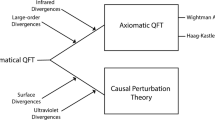Abstract
In this paper we consider excited state g-functions, that is, overlaps between boundary states and excited states in boundary conformal field theory. We find a new method to calculate these overlaps numerically using a variation of the truncated conformal space approach. We apply this method to the Lee-Yang model for which the unique boundary perturbation is integrable and for which the TBA system describing the boundary overlaps is known. Using the truncated conformal space approach we obtain numerical results for the ground state and the first three excited states which are in excellent agreement with the TBA results. As a special case we can calculate the standard g-function which is the overlap with the ground state and find that our new method is considerably more accurate than the original method employed by Dorey et al.
Similar content being viewed by others
References
V.P. Yurov and Al.B. Zamolodchikov, Truncated conformal space approach to the scaling Lee-Yang model, Int. J. Mod. Phys. A 5 (1990) 3221.
P. Dorey, A. Pocklington, R. Tateo and G. Watts, TBA and TCSA with boundaries and excited states, Nucl. Phys. B 525 (1998) 641 [hep-th/9712197] [INSPIRE].
P. Dorey, I. Runkel, R. Tateo and G. Watts, g function flow in perturbed boundary conformal field theories, Nucl. Phys. B 578 (2000) 85 [hep-th/9909216] [INSPIRE].
Al. Zamolodchikov, Scaling Lee-Yang model on a sphere. 1. Partition function, JHEP 07 (2002) 029 [hep-th/0109078] [INSPIRE].
N. Ishibashi, The boundary and crosscap states in conformal field theories, Mod. Phys. Lett. A 4 (1989) 251 [INSPIRE].
I. Affleck and A.W. Ludwig, Universal noninteger ’ground state degeneracy’ in critical quantum systems, Phys. Rev. Lett. 67 (1991) 161 [INSPIRE].
A. LeClair, G. Mussardo, H. Saleur and S. Skorik, Boundary energy and boundary states in integrable quantum field theories, Nucl. Phys. B 453 (1995) 581 [hep-th/9503227] [INSPIRE].
V.V. Bazhanov, S.L. Lukyanov and A.B. Zamolodchikov, Integrable quantum field theories in finite volume: excited state energies, Nucl. Phys. B 489 (1997) 487 [hep-th/9607099] [INSPIRE].
I. Runkel, Perturbed defects and T-systems in conformal field theory, J. Phys. A 41 (2008) 105401 [arXiv:0711.0102] [INSPIRE].
G.M.T. Watts, On the renormalisation group for the boundary Truncated Conformal Space Approach, KCL-MTH-11-04 [arXiv:1104.0225] [INSPIRE].
P. Wynn, On a device for computing the ϵ m (S n ) transformation, Math. Tables Aids Comput. 10 (1956) 91.
Al. Zamolodchikov, Thermodynamic Bethe Ansatz in relativistic models. Scaling three state potts and Lee-Yang models, Nucl. Phys. B 342 (1990) 695 [INSPIRE].
P. Dorey and R. Tateo, Excited states by analytic continuation of TBA equations, Nucl. Phys. B 482 (1996) 639 [hep-th/9607167] [INSPIRE].
Al.B. Zamolodchikov, On the thermodynamic Bethe ansatz equations for reflectionless ADE scattering theories, Phys. Lett. B 253 (1991) 391 [INSPIRE].
P. Dorey, D. Fioravanti, C. Rim and R. Tateo, Integrable quantum field theory with boundaries: the exact g function, Nucl. Phys. B 696 (2004) 445 [hep-th/0404014] [INSPIRE].
B. Pozsgay, On O(1) contributions to the free energy in Bethe Ansatz systems: the exact g-function, JHEP 08 (2010) 090 [arXiv:1003.5542] [INSPIRE].
T. Quella, I. Runkel and G.M.T. Watts, Reflection and transmission for conformal defects, JHEP 04 (2007) 095 [hep-th/0611296] [INSPIRE].
M. Kormos, I. Runkel and G.M.T. Watts, Defect flows in minimal models, JHEP 11 (2009) 057 [arXiv:0907.1497] [INSPIRE].
Wolfram Research Inc, Mathematica, version 8.0, Champaign U.S.A. (2010).
Author information
Authors and Affiliations
Corresponding author
Additional information
ArXiv ePrint: 1112.2906
Rights and permissions
About this article
Cite this article
Takács, G., Watts, G.M.T. Excited state g-functions from the truncated conformal space. J. High Energ. Phys. 2012, 82 (2012). https://doi.org/10.1007/JHEP02(2012)082
Received:
Accepted:
Published:
DOI: https://doi.org/10.1007/JHEP02(2012)082



